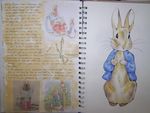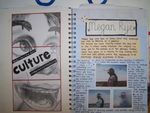Fine Art AQA AS Level Art
←
→
Page content transcription
If your browser does not render page correctly, please read the page content below
1
Fine Art AQA AS Level Art
What does the exam board say?……………………………..
Candidates should produce practical and critical/contextual work in one or more areas including
painting, drawing, mixed-media, sculpture, land art, installation, printmaking, film, animation,
television, video and photography: lens-based and/or light-based media.
Candidates may submit in their portfolio:
• A selection of thoughtfully presented work that demonstrates the breadth and depth of the
course of study.
• At least one extended collection of work, or project, based on an idea, concept, theme or
issue which demonstrates the candidate’s ability to sustain work from an initial starting point to a
realisation and includes evidence of their ability to research, develop ideas and link their work in
a meaningful way to related critical/contextual materials.
• Critical/contextual work which could include written materials, such as journals, reviews,
reflections and evaluations, annotations and historical background material. Examples
of video, film, photographs, CD Roms and Powerpoint presentations may also be submitted.
Evidence may also be included from the Internet, from books and journals, as well as studies made
during a residency, site or gallery/museum visit. When appropriate sources should be identified
and acknowledged.
• Sketchbooks, workbooks and journals. Alternatively, candidates may wish to present a
series of related images on mounted sheets.
They should be made aware of both traditional and new technologies.
Candidates should explore relevant images, artefacts and resources relating to art and design from
the past and from recent times, including European and non-European examples. This should be
integral to the investigating and making process. Their responses to these examples must be shown
through practical and critical activities which demonstrate the candidates’ understanding of different
styles, genres and traditions.
Candidates should be aware of the four assessment objectives to be demonstrated in the content
and skills presented and of the importance of process as well as product.
Candidates should explore drawing using a variety of methods and media on a variety of scales.
Candidates should use sketchbooks/workbooks/ journals to underpin their work where appropriate.
Knowledge and Understanding
Candidates must show knowledge and understanding of:
• how ideas, feelings and meanings can be conveyed and interpreted in images and artefacts
in the chosen area(s) of study within Fine Art • historical and contemporary developments and
different styles and genres
• how images and artefacts relate to social, environmental, cultural and/or ethical contexts,
and to the time and place in which they were created
• continuity and change in different styles, genres and traditions relevant to Fine Art
• the working vocabulary and specialist terminology which is relevant to their chosen area(s) of Fine
Art.
Assessment Objectives (AOs)4 emeofassessment
The Assessment Objectives are common to AS and A Level. The assessment units will assess the
following Assessment Objectives in the context of the content and skills set out in Section 3
AO1 Develop their ideas through sustained and focused investigations informed by contextual
and other sources, demonstrating analytical and critical understanding.
AO2 Experiment with and select appropriate resources, media, materials, techniques and
processes, reviewing and refining their ideas as their work develops.
AO3 Record in visual and/or other forms ideas, observations and insights relevant to their
intentions, demonstrating an ability to reflect on their work and progress2
AO4 Present a personal, informed and meaningful response demonstrating critical
understanding,
realising intentions and, where appropriate, making connections between visual, written,
oral or other elements.
Quality of making
The ability to handle materials, techniques and processes effectively and safely underpins all the
Assessment Objectives. It is important in enabling candidates to develop a personal language, to
express ideas and link their intentions to outcomes in a confident and assured manner.
Quality of Written Communication (QWC)
In GCE specifications which require candidates to produce written material in English candidates
must:
• ensure that text is legible and that spelling, punctuation and grammar are accurate so that
meaning is clear
• select and use a form and style of writing appropriate to purpose and to complex subject
matter
• organise information clearly and coherent
What do I do now???.......
…..Choose a new topic from the questions below – This will be your
“Portfolio Unit” & you will work on this 1 unit for 15 weeks so
select wisely!
New Y12 Question titles
1. Collections
Lisa Milroy’s paintings are based on collections of everyday objects. Tony Cragg and Jean Shin have
produced installations made from a collection of found objects. Christian Boltanski often uses
photographs of people and collections of related objects in his work. Produce your own response to
either a collection of related objects or a collection of found objects.
2. Crowds
The dynamics of people in a crowd have been explored by artists. This work has often has a social or
cultural dimension. Look at examples and develop a personal response.
3. Body Language
Many artists have used their observations of body language to express mood and emotion. Examples
can be seen in the work of William Blake, Edgar Degas, Edvard Munch, Egon Schiele, Heather Horton
and Sam Taylor-Wood. Look at appropriate examples and from your own observations develop a
personal response.
4. Music & instruments
Kandinsky’s abstract paintings were often closely linked to music. The Cubist often made reference to
musical instruments in their work. Arman assembled sculptures from musical instruments. Research
appropriate examples and respond in your own way to this theme.
5. Closely Observed
The pursuit of realism often involves the making of closely observed studies and has been enhanced
by the use of digital media and devices such as camera obscura. Examples can be seen in trompe-l’oeil
paintings and in the work of Vermeer, Andrew Holmes and Craig Wylie. Look at appropriate examples
and respond in your own way to this theme.3
6. Art as Propaganda
Artist from many periods and cultures have produced work which can be viewed as propaganda
because it promotes a particular idea, cause or political dogma. Examples can be seen in Russian
Socialist Realism and in the work of Philip Zec, Norman Rockwell and Michael Sandle. Consider
appropriate work and develop your own response which promotes a particular idea or cause.
How is my work marked and what do I need to have in my work to
succeed?.........
AS/A level Art – Ways to succeed.
Your work is marked in 4 sections (Assessment Objectives). Each section is
worth up to 20 marks. Portfolio work (Project1) is worth 50% of your final grade
and the Externally set assignment (Project 2) is worth 50%.
A01 – Develop their ideas through investigations informed by contextual and other
sources demonstrating analytical and cultural understanding.
What does this mean?.....
Use your own words-
Explain why and how exactly looking at this work helps you with the
development of your own work. (Use the writing frames).
Do good quality, large (at least A4 size) examples of the artist’s work
yourself which is relevant to yours in an appropriate media (i.e. Paint if that
is what they used).
You should try to use more than one artist or movement.
A02 – Refine their ideas through experimenting and selecting appropriate
resources, media, materials, techniques and processes.
What does this mean?.....
Use the images seen in AO3 to experiment with and develop your ideas
from.
Remember to use your AO1 link.
Produce a range of plans.
Use ICT such as Photoshop to help (but practise using a range of
media/colours in addition to this).
Annotate and evaluate, explaining AO1 link.
Include plan of final design (AO4).
A03 - Record ideas, observations and insights relevant to their intentions in
visual and/or other forms.
What does this mean?.....
Create a range of images.
Work in a range of media.
Demonstrate analytical skill in your work.4
Work from direct observation as much as possible.
Take your own photos.
Do NOT rely on second-hand source material.
A04 – Make a personal resolved piece as a conclusion to your journey, showing a
link to your chosen Artist/Designer.
What does this mean?.....
This must be at least full 10hours worth of work.
Must link to A01.
What do I need to do over the Summer before Sept.’13?.........
... Work on the A01 section of your project…
1. - Use your own words- hand write or word process. Use
the writing frame “Critical Studies…FEED YOUR IDEAS”
to explain why and how exactly looking at this work helps
you with the development of your own work/ideas.
2. - Annotate don’t describe the examples you print out.
3. - Do good quality, large (at least A4 size) examples (at
least 2) of the artist’s work yourself which is relevant to
yours in an appropriate media (i.e. Paint if that is what
they used).5
Critical Studies -“FEED YOUR IDEAS”
IN YOUR OWN WORDS explore aspects such as-
Time, place & circumstances in which work was produced. Does
it look observed, remembered or imagined? What is its
purpose? Why was it created? What have you learnt about it?
How the subject, theme, idea or issue has been interpreted by
the artist.
The ways in which techniques & materials have been used.
The FORMAL elements of the painting – use of line, shape,
colour (& their relationship to each other or the piece), tone,
texture, 3D-form. REMEMBER TO ADD TITLE & DATE OF PIECES
STUDIED.
The mood & atmosphere of the piece & how it is created.6
The FORMAT (layout & presentation) composition & layout
(arrangement of image/s).
What are your thoughts, likes & dislikes of the work, ideas,
techniques, processes & media? Your initial thoughts & those
now have studied piece?
Acknowledge all sources please. Write what you have learnt
about the artist/their work from studying them but please
acknowledge the source – do NOT try to pass it off as your own
words!
How did others do it last year?..........8 Any Questions still?.............I will be in school until 12.30pm Weds 17th July – please contact me and ask – cmedcroft@crypt.gloucs.sch.uk Enjoy your Summer! Mrs Medcroft
You can also read



























































